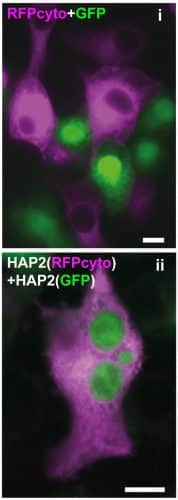Researchers at the Faculty of Biology at the Technion and their colleagues in the US and South America present the importance of "fusxins" in sexual reproduction, viral infection and organ growth

Researchers in the Faculty of Biology at the Technion and their colleagues in Argentina, Uruguay and the USA publish dramatic findings concerning the intercellular fusion process. The study was published last week in the journal JCB - The Journal of Cell Biology.
Cell-cell fusion is a process in which two cells adhere to each other, their membranes loosen in the area of contact and the two cells become one. The fusion is essential for significant biological processes including sexual reproduction, viral infection and the growth of organs in the body. This is because in the process of fertilization, the sperm cell and the egg cell come together; In a viral infection, the virus and a cell of the host organism unite; And in the growth of organs, several cells of the same organism unite and form a multinucleated cell.
Prof. Benny Podbilevitz and Clary Valensi from the Faculty of Biology at the Technion, examined in the current study the activity of HAP2 fusion proteins (GCS1) in mammalian cells.
The main discovery in the study is that HAP2 proteins are not only vital in the fusion process but also are enough on their own for its existence. In other words, the presence of HAP2 allows two cells to fuse even without other fusion proteins. "In fact," says Prof. Podbilevich, "we are talking about a 'superfamily' of proteins whose existence is sufficient to bring about the essential fusion processes in sexual reproduction (sperm-egg fusion), in viral infection (for example in the Zika epidemic) and in the growth of organs. Due to their vital role in a variety of intercellular fusion events, we call these proteins fusexins - a term that combines the words fusion and sex."
The South American research groups were responsible for the computational predictions, while the Technion researchers performed the laboratory experiments. HAP2 proteins were taken from a plant source - the white sedum plant (Arabidopsis thaliana) - and used to create fusion in mammalian cells. This is how the researchers discovered that the success of the fusion is dependent on the presence of fusxins inother the candidate cells for fusion. The fusion is successful even if the fosxins are in one of these two cells, provided that EFF-1 is found in the other cell - a fusion protein that has already been extensively studied in the Podbilevich laboratory. It is worth noting that what is common to the superfamily of the fusxins is not the genetic sequence but the three-dimensional structure.
The beginning of sexual reproduction
In light of the effect of the fusxins in a variety of biological processes, the researchers hypothesize that this is a very ancient protein family, which brought sexual reproduction to the world. Until about 2.5 billion years ago, the animal world was dominated by asexual reproduction, i.e. reproduction in which the cell creates a copy of itself and thus preserves its genetic profile. The development of the process of intercellular fusion brought to the world the sexual, or sexual, reproduction, in which cells of two different creatures unite and create a new creature. The evolutionary advantage of sexual reproduction is that mixing the genetic material from two different parents creates greater biological diversity and thus increases the chances of the biological species to survive. Furthermore, this genetic mixing allows the correction of genetic errors (negative mutations), which is not possible in asexual reproduction.
Multidisciplinary research
The article brings together many fields and many research methods, including building computer models and working with living cells in culture. Prof. Benny Podbilevitz, head of the laboratory in the Faculty of Biology at the Technion, the director of the laboratory (for many years) Clary Valensi, who is the main author of the article, and PhD student Yelena Matveev participated in the writing of the article. The partners from Argentina are David Moy, another first author on the paper, who contributed to the construction of the protein model in the study, and the head of his laboratory, Pablo Aguilar. Some of the discoveries in this article were contributed by Yevgenia Lakina, a senior research fellow in the laboratory of Prof. Leonid Chernomordyk at the American Institutes of Health. The partners from Uruguay are Martin Grana from the Pasteur Institute in Montevideo and Hector Romero from the Republican University.
Prof. Podbilevitz, born in Mexico, came to Israel after finishing high school. After a period of residence in Kibbutz Nir David, he returned to Mexico, completed his undergraduate studies in Mexico City and went on to a PhD at Yale University and a post-doctorate in Cambridge. After his marriage he immigrated to Israel and since then he has been a faculty member in the Faculty of Biology at the Technion.
For an article in JCB magazine - The Journal of Cell Biology
Video: The cell membranes of the three cells in the square come together around second 3:15 (source: From the study)
